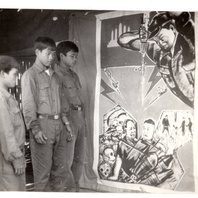
Featured Item
Three men looking at a propaganda poster
This picture shows three young male soldiers looking at a poster that represents a soldier of the Kampuchea United Front for National Salvation (KUFNS, also known as FUNSK) [Front or Renakse] aiming his rifle with bayonet at the enemies, Pol Pot and Ieng Sary. The drawing next to Pol Pot’s head is a reproduction of a photograph of killings by Khmer Rouge guards that were published between April 1976 and January 1978 in the mainstream Western media. Different stories circulated about the origin of those pictures. Some said they had been smuggled out of Cambodia by a relative of the photographer, who himself had died while trying to escape, or by a Cambodian refugee in Paris who refused to reveal his identity. According to Sygma Photo News (the agency which had distributed the original pictures), the images came from Khmer Rouge defectors. In fact, the photos had first appeared in a Thai newspaper in April 1976 and were reprinted in the Bangkok Post under the headline “True or false?” a few days later. The newspaper explained that they had first refused to buy the images from the Thai trader who tried to sell them because they had doubted their authenticity. Even American intelligence services thought the pictures were fake. The photographs, it turned out, were part of an operation by the Thai intelligence services. They had been staged and taken in Thailand. This photograph is part of the collection held by the Agence Khmère de Presse (AKP) and Cambodia’s Ministry of Information. This collection, which documents the early years of the People’s Republic of Kampuchea as photographed by the Vietnamese and a small team of Cambodian photographers, has not yet been classified or indexed.
Read More
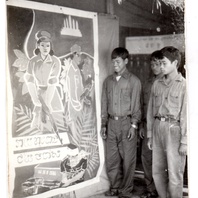
Featured Item
Three men beside a propaganda poster
This photograph shows of three young soldiers standing next to a poster representing two soldiers (a man and a woman) from the Kampuchea United Front for National Salvation (KUFNS, also known as FUNSK) [Front or Renakse] fighting against the Khmer Rouge-Chinese enemy. The three soldiers stand at the entrance to a hut. The poster is about 1.80 metres in height. It is pinned on the hut’s external wall. It shows a female soldier and a male soldier standing below the Kampuchea United Front for National Salvation flag. The female soldier points her rifle to the bottom of the poster, at the enemy. The latter is clad in black and wears a krama (traditional scarf). He is obviously a Khmer Rouge fighter. The writing in Khmer, at the centre of the poster, reads: “Fight for victory”. This photograph is part of the collection held by the Agence Khmère de Presse (AKP) and Cambodia’s Ministry of Information. This collection, which documents the early years of the People’s Republic of Kampuchea as photographed by the Vietnamese and a small team of Cambodian photographers, has not yet been classified or indexed.
Read More
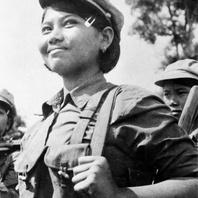
Item
Female soldier of the Kampuchea United Front for National Salvation
This unattributed photograph shows an unidentified young Cambodian female soldier of the Kampuchea United Front for National Salvation (KUFNS, also known as FUNSK) [Front or Renakse]. She is smiling and holds firmly the straps of her rucksack. This photograph is part of the collection held by the Agence Khmère de Presse (AKP) and Cambodia’s Ministry of Information. This collection, which documents the early years of the People’s Republic of Kampuchea as photographed by the Vietnamese and a small team of Cambodian photographers, has not yet been classified or indexed.
Read More
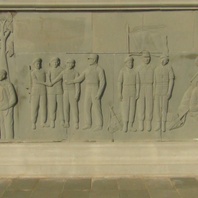
Item
Win-Win Monument bas-relief
This photograph provides a view of bas-relief on the 117-metre-long engraved base of the Win-Win Monument. It depicts negotiations between Cambodia’s military and last Khmer Rouge factions leading to the defection of the latter. The Win-Win Monument complex – photographed here in January 2020 – was inaugurated in December 2018 to mark the twentieth anniversary of the end of the post-Democratic Kampuchea civil war, with the final defection of the remaining Khmer Rouge factions, thanks to the DIFID policy (“Divide, Isolate, Finish, Integrate, Develop”) also known as the “Win Win” policy of Prime Minister Hun Sen.
Read More
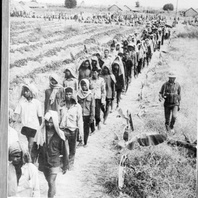
Featured Item
Khmer Rouge prisoners escorted by Vietnamese troops
This picture shows Khmer Rouge prisoners being escorted by Vietnamese soldiers during the start of the Vietnamese intervention in Cambodia. This photograph is part of the collection held by the Agence Khmère de Presse (AKP) and Cambodia’s Ministry of Information. This collection, which documents the early years of the People’s Republic of Kampuchea as photographed by the Vietnamese and a small team of Cambodian photographers, has not yet been classified or indexed.
Read More
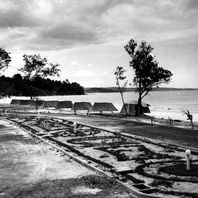
Featured Item
Beach promenade, Sihanoukville
The photograph is part of the collection that was donated to the National Archives of Cambodia from the Library of the Royal University of Fine Arts by Darryl Collins and Helen Grant Ross in 2003. The collection was used by Collins and Ross for their research into urbanisation. The images were probably originally used to mount the Sangkum Reastr Niyum Permanent Exhibition at the Exhibition Hall, Bassac area, Phnom Penh.
Read More
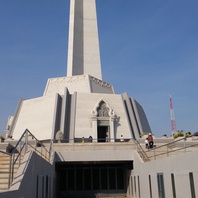
Item
Win-Win Monument
The Win-Win Monument obelisk (33 metres in height) – photographed here in January 2020 – is part of the monumental complex inaugurated in December 2018 to mark the twentieth anniversary of the end of the post-Democratic Kampuchea civil war, with the final defection of the remaining Khmer Rouge factions, thanks to the DIFID policy (“Divide, Isolate, Finish, Integrate, Develop”) also known as the “Win Win” policy of Prime Minister Hun Sen.
Read More
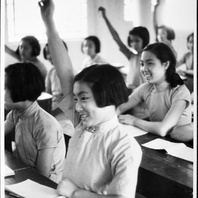
Item
Japanese language is exclusively used in the classroom
From a collection of staged photographs produced under the title “Life at a Girls School in Peking”, and produced at the Peking Jiyu Gakuen in Japanese-occupied Beijing. The original caption reads: “Japanese language is exclusively used in the classroom”.
Read More
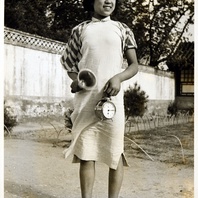
Item
“Great housewife” with the school bell [sic]
From a collection of staged photographs produced under the title “Life at a Girls School in Peking”, and produced at the Peking Jiyu Gakuen in Japanese-occupied Beijing. The original caption reads: “The girls have to bring the bell in turn every day with the title of ‘great housewife’. Chinese girls have no conception of TIME but they know morning, noon and evening. Teaching the idea of time is the first fundamental step towards a better education [sic]”.
Read More
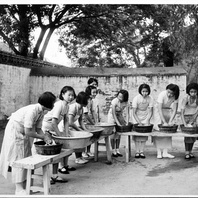
Item
Washing hour
From a collection of staged photographs produced under the title “Life at a Girls School in Peking”, and produced at the Peking Jiyu Gakuen in Japanese-occupied Beijing. The original caption reads: “Evidently the girls are enjoying a ‘new domestic arts’ [sic]”.
Read More
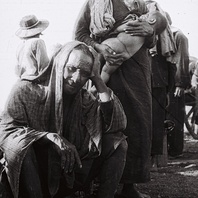
Featured Item
Group of villagers (survivors), Cambodia
This photograph is part of the collection held by the Agence Khmère de Presse (AKP) and the Ministry of Information of Cambodia. This collection, which documents the early years of the People’s Republic of Kampuchea as photographed by the Vietnamese and a small team of Cambodian photographers, has not yet been classified or indexed.
Read More
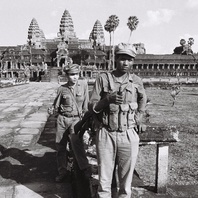
Featured Item
Soldiers at Angkor Wat
This image shows two soldiers of the Kampuchea United Front for National Salvation (KUFNS, also known as FUNSK) [Front or Renakse] posing in front of Angkor Wat. This photograph is part of the collection held by the Agence Khmère de Presse (AKP) and Cambodia’s Ministry of Information. This collection, which documents the early years of the People’s Republic of Kampuchea as photographed by the Vietnamese and a small team of Cambodian photographers, has not yet been classified or indexed.